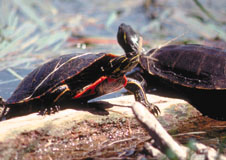|
Habitat Atlas for Wildlife at Risk
Painted Turtle
Chrysemys picta belli

Painted
Turtle
|
- Plastron (belly) length: Males: 9-17
cm, Females: up to 22 cm.
- Weight: Males: 800 g; Females: 1400 g.
- The top shell or carapace is generally black to
greenish.
- Yellow stripes on the head, neck, tail, and legs,
as well as red markings around the edges of the plastron
(belly) and under the rim of the carapace.
- Males distinguished from females by long, slender
claws on forefeet.
Habitat map not available.
Status:
British Columbia Blue List
Special Significance
The Painted Turtle requires wetlands, ponds or similar
small bodies of water for hiding and foraging, adjacent
to upland areas with dry, light-textured soils for
nesting. Unfortunately, within its limited British
Columbia range, the Painted Turtle is threatened
by alteration or destruction of this important habitat.
Wetlands and ponds are drained, filled and modified
to meet human needs. Landowners can assist the continued
survival of British Columbia's only native freshwater
turtle by taking care to avoid disturbing turtles
and protecting known breeding locations on their
property.
Distribution
- In British Columbia, turtles are irregularly distributed but locally
abundant in Southern Interior valleys, including
the Rocky Mountain Trench north to Golden, the Creston and Nelson
areas, the Okanagan
Valley and the Kamloops-Shuswap lakes area; also
a population near William's Lake; recorded in the Fraser Valley
from Vancouver to Hope,
in the Sechelt-Powell River area, and on southeast
Vancouver Island.
- Found up to about 1000 metres in elevation.
Habitat
- Painted Turtles inhabit muddy bottomed ponds and marshes, the
margins of small lakes, sluggish streams and river back-waters with
abundant
aquatic plants.
- Nest sites are usually within 150 metres of ponds and
may include dikes, road shoulders and parking lots.
- Turtles require warm, unvegetated, south-facing slopes
with dry, light soil for burying their eggs.
- Preferred basking sites include boulders, floating
logs and other sites surrounded by water.
Reproduction
- Males are sexually mature at 4 years, females at 7 or 8 years.
- Turtles mate in early spring and females lay clutches
of 6-18 (usually 12-13) leathery, white eggs
from early June to early July; one clutch produced each year.
- Eggs are incubated for 70-80 days and hatch in late
August or early September.
- Hatchlings remain in the nest until May or June of
the following year.
Food Habits
- Painted Turtles eat a variety of aquatic insects and larvae, snails,
earthworms, frogs, tadpoles, fish and aquatic plants.
- Turtles will scavenge on dead animal material.
- Studies indicate that young turtles are more carnivorous
and become more herbivorous as they mature.
Interesting Facts
- Painted Turtles can live 20-30 years and grow to be the size of
dinner plates.
- Painted Turtles are the most northerly occurring, and
most widespread turtles in North America.
- Young turtles hatch in the fall and endure winter temperatures
well below freezing before they leave the nest
in late spring or early summer.
- Because turtle ribs form part of their shell, they
are unable to breathe by expanding and contracting
ribs; instead, they contract and relax their abdominal muscles to
pump air in and
out of their lungs.
- Turtles have no external ears but their shell conducts
low-frequency vibrations to the middle ear.
- Turtles can dive to 2 metres depth while feeding and
can stay underwater for almost an hour.
- Up to ninety percent of all turtle nests are lost to
predators; of those that make it out of the nest,
only one in five will survive to adulthood.
Threats
- Alteration or destruction of wetlands and ponds
with suitable nesting sites in close proximity.
- Traffic mortality on roads adjacent to wetlands.
- Human disturbance of basking or nesting turtles.
- Trampling of turtle nests by livestock and destruction
by all-terrain vehicles.
- Illegal capture of turtles for pets.
- Release of unwanted, introduced turtles such as
the Red-eared Slider which may compete with
the Painted Turtle for food and introduce disease to native
turtle populations.
Management Considerations
- Protect key habitat including remaining wetlands,
ponds and other small waterbodies.
- Restrict the development of roads, trails, beaches
and campgrounds in key turtle habitat.
- Observe turtle basking sites from a distance
and avoid nest sites.
- Keep dogs leashed near turtle habitat and don't
pick up turtles.
- Alert provincial or municipal habitat protection
staff about land developments that threaten
turtles or their habitat.
- Restore degraded wetlands, provide basking logs
and create nesting sites.
- Erect fences around wetlands and known nesting
habitat to prevent trampling by livestock
and damage by all-terrain vehicles.
- Take unwanted, non-native turtles to the SPCA;
do not release them into the wild.
|
References
1. Blood, D.A. and M. Macartney. 1998. Wildlife at risk in British
Columbia brochure: Painted Turtle. Ministry of Water, Land and Air
Protection, Lands and Parks, Victoria, British Columbia.
2. Gregory, P.T. and R.W. Campbell. 1984. The reptiles
of British Columbia. British Columbia Provincial Museum Handbook No.
44. Victoria, BC.
3. Behler, J.L. and F.W. King. 1997. National Audubon
Society field guide to North American reptiles and amphibians. Alfred
A. Knopf, New York.
|